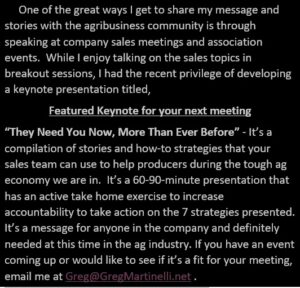Last week, we made the arduous journey of building trust with our customers over a long period of time, possibly an entire career. This week, we deal with the even longer journey of rebuilding trust with our customers after somehow breaking it.
The trust breaker might be one big event or multiple small ones.
- Maybe your feed was blamed for animal deaths
- Maybe your contract sprayer just sprayed the wrong field for the fourth time, or your contract hauler delivered to the wrong bin for the third time.
- Maybe your customer service person had a bad day and just botched the order or wouldn’t release the order because there was $1.95 in the over 30 days past due. While not a huge issue, it might just be the final tipping point that sets a customer off.
- Maybe you failed to show up on time or deliver on a promise you made to your customer for the 37th time because, in your words, “I’m so busy and I just forgot and it’s planting, it’s harvest, it’s my kids, it’s my 37th excuse.”
No matter, the situation. No matter who’s fault it is: yours, your company’s, or maybe even your customer’s. The damage is done to the trust in your relationship and you need to deal with it.
The seven steps are no different for any industry, but in the world of selling age-related products, we need to remember several critical concepts:
Critical Concepts of Selling in Agribusiness:
- Remember how small our world really is. Producers talk to each other every day at the coffee shop, the local fair or industry meetings. One producer told me, “I could go to a supplier meeting almost every day of the week if I wanted to from January through the start of planting.” What do producers do at these meetings? They talk about you and their other vendors. Word of mouth travels fast. And in the digital age, that word travels faster than gossip on the old party line phones. Bad news always travels faster than good news. When one producer tells another producer about his bad experience with your company, what is the last question they always ask? “Well, what did they do about it?” You don’t want the answer to be, “Nothing” or worse, “Denied they caused the problem”.
- This means we need to respond and not waste time when bad things happen. If it’s within your power to act or make the changes that need to be made, then do it now. Bad news gets worse with age.
- If it’s not in your power to act or make the needed changes, then communicate: with customers, with your management, and with your coworkers. Let people know what’s going on, even if no progress has been made. Let them know that you are still aware of the problem and working on it. The theory that you should let angry customers calm down never seems to work if you haven’t resolved the issue. They just get angrier with time and tell more farmers at the coffee shop. So much so, that the coffee crowd gets tired of hearing the story. Once you resolve it, THEN you can let the dust settle.
The 7 steps to rebuild trust in agribusiness
- Admit the problem: There’s nothing worse than a company not owning up to what happened. People make mistakes and your customer will allow mistakes. However, they will not tolerate denial or blaming. They don’t care who caused it. They want a solution.
- Apologize: The next step is to let the customer sincerely know how sorry you are. And a form letter from the customer service department that says, “Dear Valued Customer” is not an apology. You might as well not even send that letter. The minute your customer reads that, they think, “If I’m so valued, couldn’t you have at least put my name on it?” The apology needs to be in person or at a minimum verbally over the phone. This is also a good time to interject a sub-component of apologizing: The customer is going to vent in some form or fashion; yelling, scolding, demanding, taking business away from you, the silent treatment. Whatever it is, our job is to listen. Hear them out and stay true to these steps.
- Stop the bleeding and make it right: Depending on the severity of the problem, you need to stop any further property loss or damage. This is a top priority and will save you it turns into actual financial reimbursement on your part. Second, it gives you an opportunity to see first hand what the problem is and how it was caused. Third, by first focusing on stemming the damage, it gives you time to communicate with your customer to calm them down and focus on the facts. Often during the heat of the moment, customers can blow the issue out of proportion and make wild accusations about the damage. By getting involved at this point, you can stem these accusations. What are some typical “Stop the bleeding” tasks:
- Remove the bad product
- Replace the bad product
- Get samples, pictures, etc.
- Get an account of details on what happened, when and how
- Take good notes and clarify details
For an example of jumping into the situation, see My Third Worst Day of Selling Feed
- Don’t do it again: This is the toughest step for many companies as we can’t control every aspect of our business. Human error is part of every business. Salespeople, office staff, contract haulers, and yes, even managers are human and have bad days or make mistakes.
- Become known for the opposite: After Tylenol had the tampering crimes in the 1970’s, they reinvented the way OTC medicine was packaged. Not only did they complete the first four steps listed above, they became known for the tamper-proof bottle that all medication and many foods use today. Once the immediate bleeding is stopped, you need to bring the masses of your company’s power to attack the problem, learn from it and see if you can turn this experience into a brand strength. Again, read through My Third Worst Day of Selling Feed for an example of how we went from a crisis to having the best delivery fleet and drivers in the market area.
One last thought on being stronger after your problems: Involve your customer. If the issue is big enough and important enough, bring a group of customers into your process of fixing the problem. Trust me, if they’ve been talking about it at the coffee shop for four months, they will talk to you or your improvement team about it. If you can’t bring your customer to your office, take your office to the customer’s place of business.
- Time: Rebuilding trust takes time. Once you have completed steps 1-4 above, it’s just going to take time. How much? Was your apology sincere? Did you “make it right” in the customer’s opinion? Did you stop making the same mistakes? If your customer’s answer (not your answer nor your company’s answer) to all of these is yes, then be patient and keep going back. You’re playing for keeps for the long haul. You may need a cooling off time, but in the end, you still go back. I’ve heard salespeople say, “We’ll never sell him again” after an incident. My answer is, “Never” is a really long time and they aren’t creating more customers. So, get back on his farm in due time. See Ever Get Kicked Off a Farm? For an example of why you need to go back.
- Appreciation: Throughout the experience, understand that your customer came to you with a need and their money. You accepted their money but didn’t solve their need to their satisfaction. They just want you to understand their point of view and appreciate the stress this has caused. Remember the study done by the insurance industry that tried to find the root cause of malpractice lawsuits. Believe it or not, it’s not bad doctor care nor lawyers. The one thing they could link to a lawsuit was the doctor’s bedside manner. Patients were less likely to file a suit If their doctor listened, spent time with them, explained the procedure and made them feel heard.
These customer service nightmares are never easy nor timely nor fun to go through. However, in most cases, you are stronger and more knowledgeable. In the post “Tough Times Teach”, I explain how you become more knowledgeable after a major crisis. You know more about your business operations, alternative ways to get your products to the customer, how your coworkers and customers react to stress, and how you react to stress. You come away with an appreciation for those times when the business is flowing smoothly.
While building trust takes time, rebuilding broken trust takes even more time and focused effort to restore. Hopefully, these key concepts and seven steps will shed some light on a path you can follow when the dark times arrive. In the end, it’s not the mistakes or customer service nightmare that defines us, it’s how we react to it.






